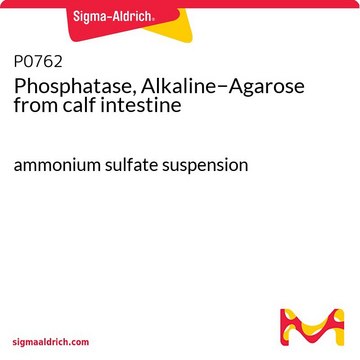API-RO
Roche
Alkaline Phosphatase (AP)
grade I, from calf intestine
Sinonimo/i:
AP, Alkaline Phosphatase
About This Item
Prodotti consigliati
Origine biologica
bovine (calf) intestine
Livello qualitativo
Forma fisica
suspension
Confezionamento
pkg of 1,500 U (10108138001)
pkg of 7,500 U (10108146001)
Produttore/marchio commerciale
Roche
pH ottimale
8.0-10.5
Assorbimento
7.6 at 278 nm (10 mg AP/ml)
Temperatura di conservazione
2-8°C
Descrizione generale
Alkaline phosphatase catalyzes the removal of phosphate group from various compounds that are phosphorylated. It hydrolyzes 5′-monophosphate groups from both DNA and RNA. It can also hydrolyze 5′-diphosphate and 5′-triphosphate groups from RNA.
Specificità
Denaturation is dependent on protein concentration - using less than 10 U/ml (0.1 mol/l glycine buffer, pH 10.5, 1 mmol/l MgCl2 and 0.1 mmol/l ZnCl2), AP is inactivated by a 10 minutes incubation at 65 °C.
Applicazioni
Qualità
Sequenza
In some mammals (e.g., humans), there are at least 3 distinguishable isoenzymes: the intestinal, the placental and the form found in bone/liver/kidney.
Definizione di unità
AP activity is not expressed in Armstrong units; a conversion factor for international units is not known.
Approx. 3.8 U (grade I AP) or 4.0 U (grade II AP) [+37 °C, 4-NPP as substrate, diethanolamine as buffer, pH 9.8] = 1 U [+25 °C, 4-NPP as substrate, glycine as buffer, pH 10.5].
Biochemica Information. 87 (grade I AP) :
1.0 U [+37 °C, QC assay conditions] = 0.79 U [+30 °C, QC assay conditions] = 0.57 U [+25 °C, QC assay conditions]
Stato fisico
Nota sulla preparazione
- Activator: Divalent metal ions (Mg2+, Co2+, Mn2+)
- Amino alcohols (2-amino-2-methyl-1-propanol, diethanolamine)
Note that high concentrations of amino alcohols can as well act as competitive inhibitors (e.g., monoethanolamine in diethanolamine).
Storage conditions (working solution): The suspension is offered at a c= approx. 5 mg/ml.
If this suspension is diluted only 5 to 10-fold with further 3.2 M ammonium sulfate solution, 1 mM MgCl2, 0.1 mM ZnCl2, pH approx. 7, we would expect from general experience that a stability for some weeks might be given provided it is stored at 4 °C (no guarantee!).
Altre note
Codice della classe di stoccaggio
12 - Non Combustible Liquids
Classe di pericolosità dell'acqua (WGK)
WGK 1
Punto d’infiammabilità (°F)
does not flash
Punto d’infiammabilità (°C)
does not flash
Certificati d'analisi (COA)
Cerca il Certificati d'analisi (COA) digitando il numero di lotto/batch corrispondente. I numeri di lotto o di batch sono stampati sull'etichetta dei prodotti dopo la parola ‘Lotto’ o ‘Batch’.
Possiedi già questo prodotto?
I documenti relativi ai prodotti acquistati recentemente sono disponibili nell’Archivio dei documenti.
I clienti hanno visto anche
Protocolli
Alkaline Phosphatase (AP) Protocol
Il team dei nostri ricercatori vanta grande esperienza in tutte le aree della ricerca quali Life Science, scienza dei materiali, sintesi chimica, cromatografia, discipline analitiche, ecc..
Contatta l'Assistenza Tecnica.






